The SPR-Index: A Novel Metric Integrating the H-Index with Verified Peer Review Scores
Abstract
1. Introduction
2. Materials and Methods
2.1. Data Acquisition and Validation
2.2. Peer Review Metric
2.3. SPR-Index Calculation
2.4. Correction Factor and Definition of the corrSPR-Index
2.5. The Inclusion of Review Length as a Second Correction Factor
2.6. Statistical Analysis
3. Results
4. Discussion
5. Conclusions
Supplementary Materials
Author Contributions
Funding
Data Availability Statement
Acknowledgments
Conflicts of Interest
Abbreviations
| SPR-index | Scientific Peer Review Index |
| H-index | Hirsch index |
| IF | Impact factor |
| NP | Number of publications |
References
- Adler, R., Ewing, J., & Taylor, P. (2009). Citation statistics. Statistical Science, 24, 1–14. [Google Scholar] [CrossRef]
- Ameer, M., & Afzal, M. T. (2019). Evaluation of h-index and its qualitative and quantitative variants in Neuroscience. Scientometrics, 121(2), 653–673. [Google Scholar] [CrossRef]
- Bornmann, L. (2011). Scientific peer review. Annual Review of Information Science and Technology, 45, 197–245. [Google Scholar] [CrossRef]
- Bornmann, L., & Daniel, H. D. (2007). What do we know about the h index? Journal of the American Society for Information Science and Technology, 58, 1381–1385. [Google Scholar] [CrossRef]
- Bornmann, L., & Daniel, H. D. (2009). The state of h-index research. EMBO Reports, 10, 2–6. [Google Scholar] [CrossRef]
- Chigbu, U. E., Atiku, S. O., & Du Plessis, C. C. (2023). The science of literature reviews: Searching, identifying, selecting, and synthesising. Publications, 11, 2. [Google Scholar] [CrossRef]
- Cochran, W. G. (1977). Sampling techniques (3rd ed.). John Wiley & Sons. [Google Scholar]
- Costas, R., & van Leeuwen, T. N. (2012). Approaching the “reward triangle”: General analysis of the presence of funding acknowledgments and “peer interactive communication” in scientific publications. Journal of the American Society for Information Science and Technology, 63, 1647–1658. [Google Scholar] [CrossRef]
- Ding, J., Liu, C., & Kandonga, G. A. (2020). Exploring the limitations of the h index and h type indexes in measuring the research performance of authors. Scientometrics, 122, 1303–1322. [Google Scholar] [CrossRef]
- Egghe, L. (2006). Theory and practice of the g-index. Scientometrics, 69, 131–152. [Google Scholar] [CrossRef]
- El-Guebaly, N., Foster, J., Bahji, A., & Hellman, M. (2023). The critical role of peer reviewers: Challenges and future steps. Nordisk Alkohol Narkotikatidskrift, 40, 14–21. [Google Scholar] [CrossRef]
- Franceschini, F., Galetto, M., Maisano, D. A., & Mastrogiacomo, L. (2012). The success-index: An alternative approach to the h-index for evaluating an individual’s research output. Scientometrics, 92(3), 621–641. [Google Scholar] [CrossRef]
- Gingras, Y. (2016). Bibliometrics and research evaluation: Uses and abuses. MIT Press. [Google Scholar] [CrossRef]
- Glänzel, W. (2006). On the h-index—A mathematical approach to a new measure of publication activity and citation impact. Scientometrics, 67, 315–321. [Google Scholar] [CrossRef]
- Haustein, S., & Larivière, V. (2015). The use of bibliometrics for assessing research: Possibilities, limitations and adverse effects. In I. M. Welpe, J. Wollersheim, S. Ringelhan, & M. Osterloh (Eds.), Incentives and performance: Governance of knowledge-intensive organizations (pp. 121–139). Springer International Publishing. [Google Scholar]
- Hirsch, J. E. (2005). An index to quantify an individual’s scientific research output. Proceedings of the National Academy of Sciences, 102, 16569–16572. [Google Scholar] [CrossRef] [PubMed]
- Ioannidis, J. P., Boyack, K. W., & Klavans, R. (2014). Estimates of the continuously publishing core in the scientific workforce. PLoS ONE, 9, e101698. [Google Scholar] [CrossRef]
- Kamrani, P., Dorsch, I., & Stock, W. G. (2021). Do researchers know what the h-index is? And how do they estimate its importance? Scientometrics, 126, 5489–5508. [Google Scholar] [CrossRef]
- Khurana, P., & Sharma, K. (2022). Impact of h-index on author’s rankings: An improvement to the h-index for lower-ranked authors. Scientometrics, 127(8), 4483–4498. [Google Scholar] [CrossRef]
- Koltun, V., & Hafner, D. (2021). The h-index is no longer an effective correlate of scientific reputation. PLoS ONE, 16, e0253397. [Google Scholar] [CrossRef]
- Moed, H. F. (2017). Citation analysis in research evaluation. Springer. [Google Scholar] [CrossRef]
- Nguyen, L. T., & Tuamsuk, K. (2024). Unveiling scientific integrity in scholarly publications: A bibliometric approach. International Journal of Educational Integrity, 20, 16. [Google Scholar] [CrossRef]
- Perneger, T. (2023). Authorship and citation patterns of highly cited biomedical researchers: A cross-sectional study. Research Integrity and Peer Review, 8, 13. [Google Scholar] [CrossRef]
- Qiao, L., Zhao, S. X., Ji, Y., & Li, W. (2025). A measure and the related models for characterizing the usage of academic journal. Journal of Informetrics, 19, 101643. [Google Scholar] [CrossRef]
- R Core Team. (2024). R: A language and environment for statistical computing. R Foundation for Statistical Computing, Vienna, Austria. Available online: https://www.R-project.org/ (accessed on 20 March 2025).
- Ross-Hellauer, T. (2017). What is open peer review? A systematic review. F1000Research, 6, 588. [Google Scholar] [CrossRef]
- Ruiz-Castillo, J., & Waltman, L. (2015). Field-normalized citation impact indicators using algorithmically constructed classification systems of science. Journal of Informetrics, 9, 102–117. [Google Scholar] [CrossRef]
- Schubert, A., & Glänzel, W. (2007). A systematic analysis of Hirsch-type indices for journals. Journal of Informetrics, 1, 179–184. [Google Scholar] [CrossRef]
- Smith, R. (2006). Peer review: A flawed process at the heart of science and journals. Journal of the Royal Society of Medicine, 99, 178–182. [Google Scholar] [CrossRef]
- Teixeira da Silva, J. A., & Dobránszki, J. (2015). Problems with traditional science publishing and finding a wider niche for post-publication peer review. Accountability in Research, 22, 22–40. [Google Scholar] [CrossRef] [PubMed]
- Teixeira da Silva, J. A., & Nazarovets, S. (2022). The role of Publons in the context of open peer review. Publishing Research Quarterly, 38, 760–781. [Google Scholar] [CrossRef]
- Tennant, J. P. (2018). The state of the art in peer review. FEMS Microbiology Letters, 365, fny204. [Google Scholar] [CrossRef]
- Tennant, J. P., Dugan, J. M., Graziotin, D., Jacques, D. C., Waldner, F., Mietchen, D., Elkhatib, Y., Collister, B. L., Pikas, C. K., Crick, T., Masuzzo, P., Caravaggi, A., Berg, D. R., Niemeyer, K. E., Ross-Hellauer, T., Mannheimer, S., Rigling, L., Katz, D. S., Greshake Tzovaras, B., … Colomb, J. (2017). A multi-disciplinary perspective on emergent and future innovations in peer review. F1000Research, 6, 1151. [Google Scholar] [CrossRef]
- Tennant, J. P., & Ross-Hellauer, T. (2020). The limitations to our understanding of peer review. Research Integrity and Peer Review, 5, 6. [Google Scholar] [CrossRef]
- Tennant, J. P., Waldner, F., Jacques, D. C., Masuzzo, P., Collister, L. B., & Hartgerink, C. H. (2016). The academic, economic and societal impacts of open access: An evidence-based review. F1000Research, 5, 632. [Google Scholar] [CrossRef]
- Waltman, L. (2016). A review of the literature on citation impact indicators. Journal of Informetrics, 10, 365–391. [Google Scholar] [CrossRef]
- Waltman, L., & van Eck, N. J. (2015). Field-normalized citation impact indicators and the choice of an appropriate counting method. Journal of Informetrics, 9, 872–894. [Google Scholar] [CrossRef]
- Wickham, H. (2016). ggplot2: Elegant graphics for data analysis. Springer-Verlag New York. ISBN 978-3-319-24277-4. Available online: https://ggplot2.tidyverse.org (accessed on 20 March 2025).
- Wouters, P., Sugimoto, C. R., Larivière, V., McVeigh, M. E., Pulverer, B., de Rijcke, S., & Waltman, L. (2019). Rethinking impact factors: Better ways to judge a journal. Nature, 569, 621–623. [Google Scholar] [CrossRef] [PubMed]
- Yan, X., Zhai, L., & Fan, W. (2012). C-index: A weighted network node centrality measure for collaboration competence. Journal of Informetrics, 6, 603–612. [Google Scholar] [CrossRef]
- Zhao, S. X., Rousseau, R., & Ye, F. Y. (2011). h-degree as a basic measure in weighted networks. Journal of Informetrics, 5, 668–677. [Google Scholar] [CrossRef]
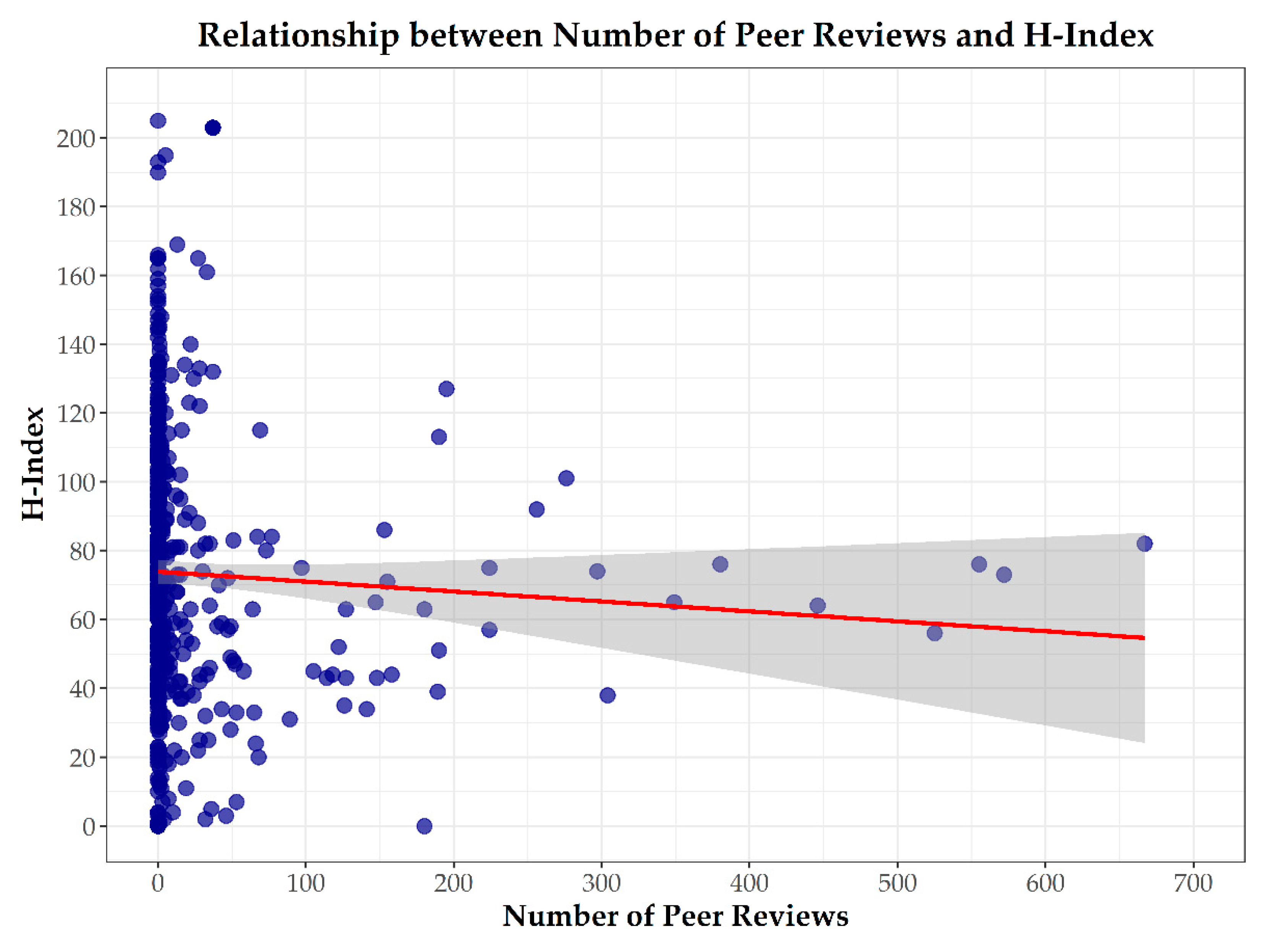
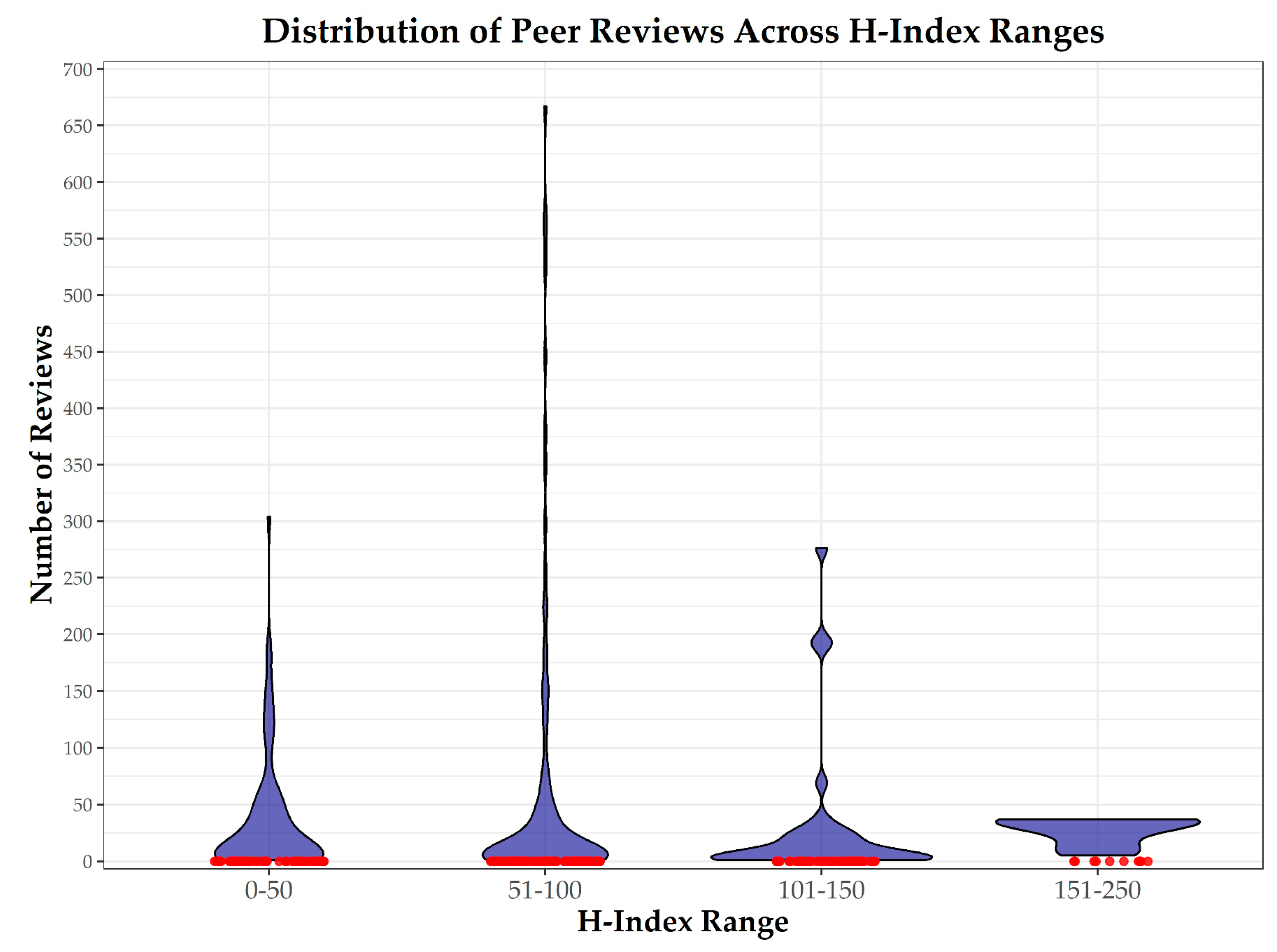
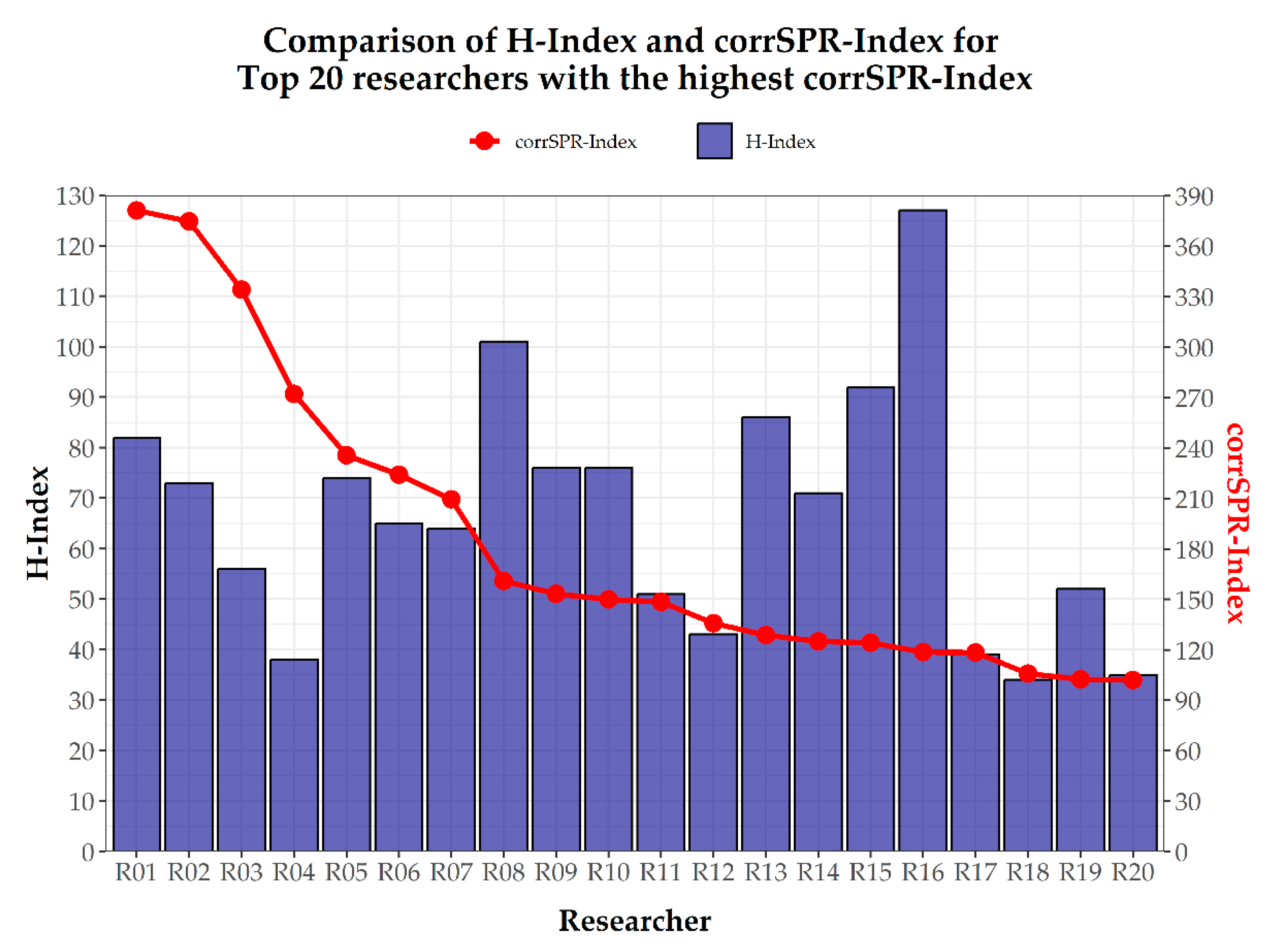
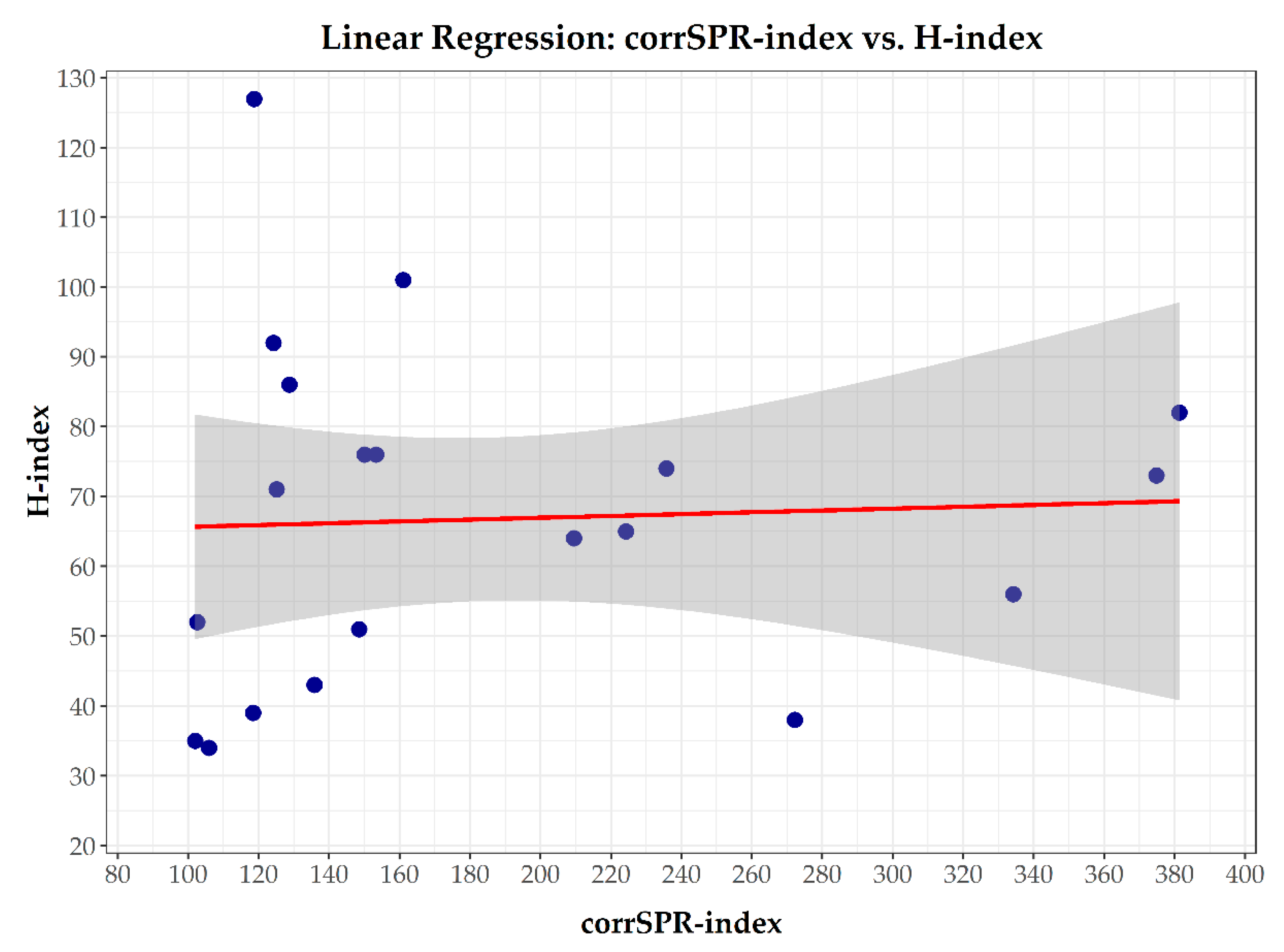
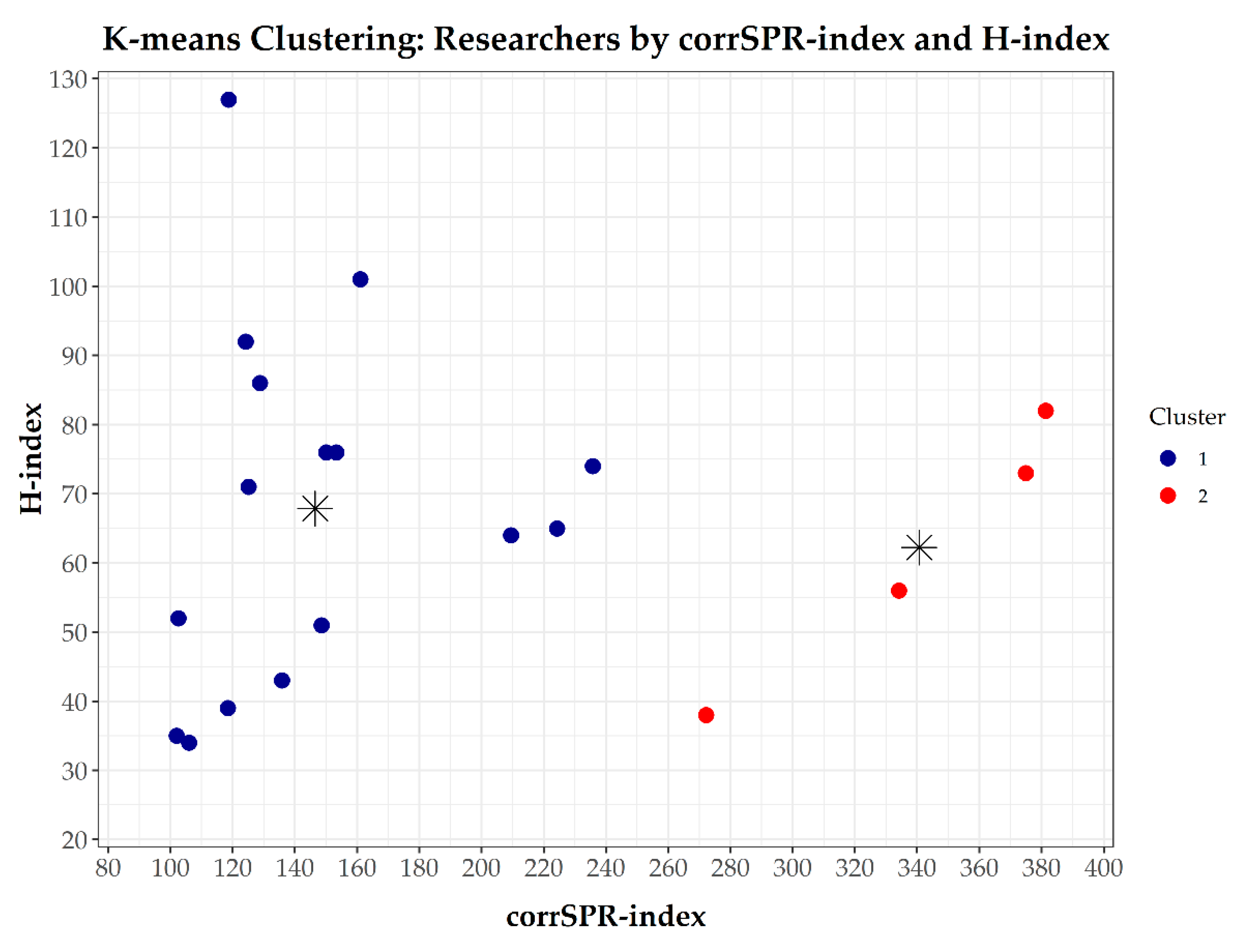

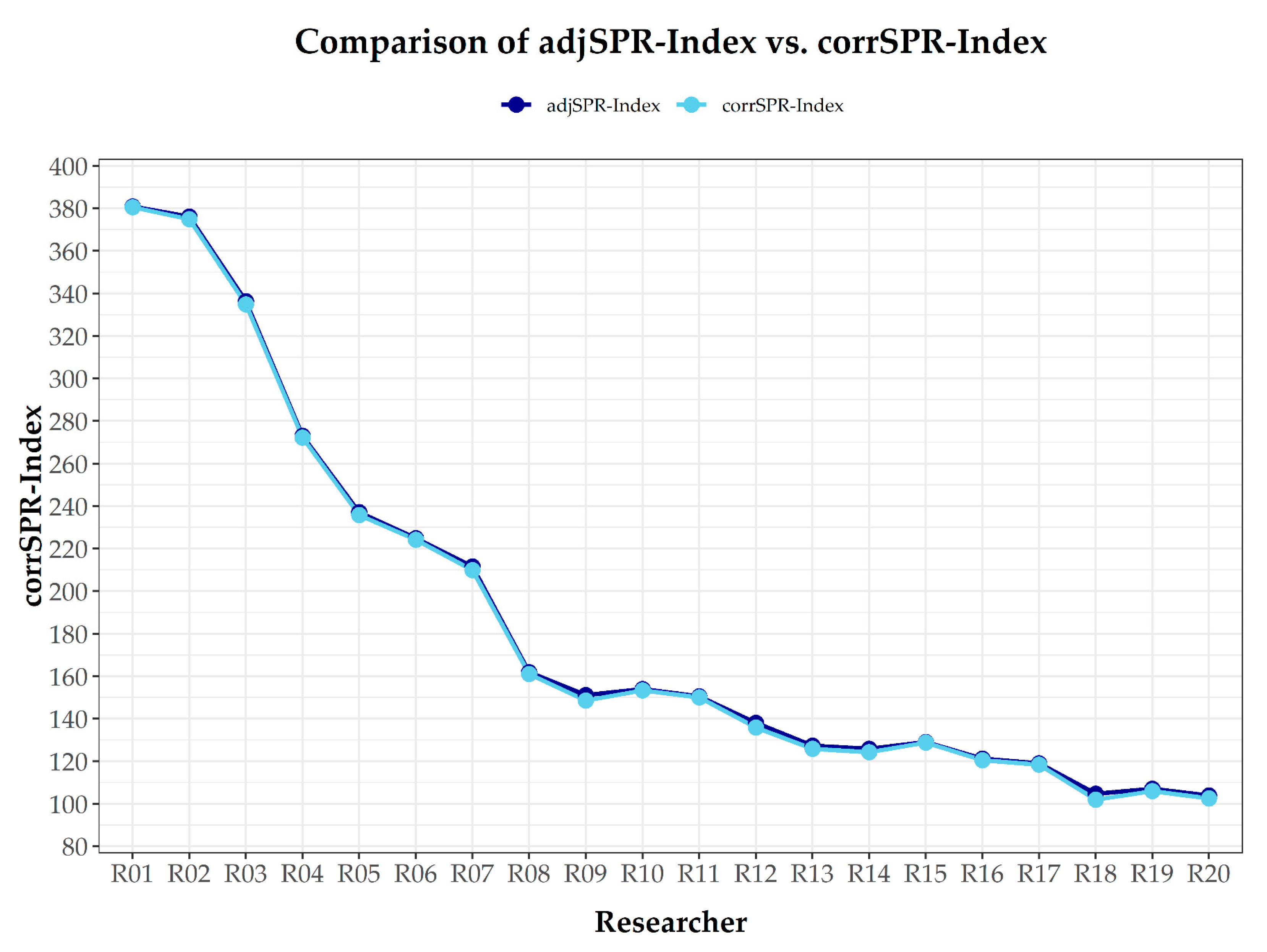
| H-Index | corrSPR-Index | ID Number | Profile | Publications | Sum of Times Cited | Reviews | Average Review Length | Peer Review Metrics | Collection Date (2025) |
|---|---|---|---|---|---|---|---|---|---|
| 205 | - | F-1813-2013 | https://www.webofscience.com/wos/author/record/F-1813-2013, accessed on 20 April 2025 | 668 | 258,199 | 0 | 0 | - | 6-Feb |
| 203 | 24.26 | AAC-5044-2019 | https://www.webofscience.com/wos/author/record/AAC-5044-2019, accessed on 20 April 2025 | 917 | 144,923 | 37 | 559 | 0.04 | 4-Feb |
| 195 | 1.35 | AFL-3518-2022 | https://www.webofscience.com/wos/author/record/AFL-3518-2022, accessed on 20 April 2025 | 2450 | 168,643 | 5 | 276 | 0.00 | 4-Feb |
| 193 | - | ADA-0497-2022 | https://www.webofscience.com/wos/author/record/ADA-0497-2022, accessed on 20 April 2025 | 1065 | 152,473 | 0 | 0 | - | 3-Feb |
| 190 | - | D-1800-2014 | https://www.webofscience.com/wos/author/record/D-1800-2014, accessed on 20 April 2025 | 745 | 157,657 | 0 | 0 | - | 10-Feb |
| 169 | 3.15 | ABE-6383-2020 | https://www.webofscience.com/wos/author/record/ABE-6383-2020, accessed on 20 April 2025 | 2355 | 205,660 | 13 | 331 | 0.01 | 10-Feb |
| 166 | - | AAQ-5140-2020 | https://www.webofscience.com/wos/author/record/AAQ-5140-2020, accessed on 20 April 2025 | 1133 | 122,138 | 0 | 0 | - | 10-Feb |
| 165 | 4.84 | Y-3070-2019 | https://www.webofscience.com/wos/author/record/Y-3070-2019, accessed on 20 April 2025 | 3231 | 145,562 | 27 | 115 | 0.01 | 6-Feb |
| 165 | - | B-7840-2010 | https://www.webofscience.com/wos/author/record/B-7840-2010, accessed on 20 April 2025 | 480 | 164,833 | 0 | 0 | - | 2-Feb |
| 165 | - | ADH-8497-2022 | https://www.webofscience.com/wos/author/record/ADH-8497-2022, accessed on 20 April 2025 | 846 | 121,839 | 0 | 0 | - | 2-Feb |
| 162 | - | ABE-9307-2021 | https://www.webofscience.com/wos/author/record/ABE-9307-2021, accessed on 20 April 2025 | 720 | 97,265 | 0 | 0 | - | 3-Feb |
| 161 | 13.63 | ADZ-0156-2022 | https://www.webofscience.com/wos/author/record/ADZ-0156-2022, accessed on 20 April 2025 | 1200 | 172,659 | 33 | 234 | 0.03 | 6-Feb |
| 159 | - | K-9344-2013 | https://www.webofscience.com/wos/author/record/K-9344-2013, accessed on 20 April 2025 | 809 | 87,146 | 0 | 0 | - | 3-Feb |
| 157 | - | D-3458-2014 | https://www.webofscience.com/wos/author/record/D-3458-2014, accessed on 20 April 2025 | 1678 | 115,272 | 0 | 0 | - | 10-Feb |
| 154 | - | C-1706-2012 | https://www.webofscience.com/wos/author/record/C-1706-2012, accessed on 20 April 2025 | 891 | 104,601 | 0 | 0 | - | 10-Feb |
| 153 | - | C-3638-2011 | https://www.webofscience.com/wos/author/record/C-3638-2011, accessed on 20 April 2025 | 2148 | 110,880 | 0 | 0 | - | 6-Feb |
| 152 | - | A-3431-2008 | https://www.webofscience.com/wos/author/record/A-3431-2008, accessed on 20 April 2025 | 1302 | 109,736 | 0 | 0 | - | 10-Feb |
| 149 | - | JPA-2618-2023 | https://www.webofscience.com/wos/author/record/JPA-2618-2023, accessed on 20 April 2025 | 783 | 89,928 | 0 | 0 | - | 4-Feb |
| 148 | 0.64 | O-6454-2015 | https://www.webofscience.com/wos/author/record/O-6454-2015, accessed on 20 April 2025 | 1452 | 136,938 | 2 | Not showed | 0.00 | 10-Feb |
| 147 | - | K-8941-2012 | https://www.webofscience.com/wos/author/record/K-8941-2012, accessed on 20 April 2025 | 489 | 74,871 | 0 | 0 | - | 4-Feb |
| 145 | 0.88 | G-4142-2012 | https://www.webofscience.com/wos/author/record/G-4142-2012, accessed on 20 April 2025 | 436 | 84,062 | 1 | Not showed | 0.00 | 10-Feb |
| 145 | - | E-2959-2010 | https://www.webofscience.com/wos/author/record/E-2959-2010, accessed on 20 April 2025 | 932 | 115,272 | 0 | 0 | - | 10-Feb |
| 144 | - | F-2571-2011 | https://www.webofscience.com/wos/author/record/F-2571-2011, accessed on 20 April 2025 | 1951 | 124,851 | 0 | 0 | - | 5-Feb |
| 142 | - | AAI-7767-2021 | https://www.webofscience.com/wos/author/record/AAI-7767-2021, accessed on 20 April 2025 | 1717 | 88,249 | 0 | 0 | - | 6-Feb |
| 140 | 5.46 | A-6599-2008 | https://www.webofscience.com/wos/author/record/A-6599-2008, accessed on 20 April 2025 | 1843 | 92,497 | 22 | 352 | 0.01 | 4-Feb |
| 140 | 0.53 | HTS-1256-2023 | https://www.webofscience.com/wos/author/record/HTS-1256-2023, accessed on 20 April 2025 | 755 | 86,555 | 1 | Not showed | 0.00 | 3-Feb |
| 138 | 0.28 | LPP-2269-2024 | https://www.webofscience.com/wos/author/record/LPP-2269-2024, accessed on 20 April 2025 | 1584 | 72,881 | 1 | Not showed | 0.00 | 6-Feb |
| 136 | 1.20 | E-9390-2011 | https://www.webofscience.com/wos/author/record/E-9390-2011, accessed on 20 April 2025 | 636 | 94,453 | 2 | 161 | 0.00 | 10-Feb |
| 135 | - | S-6474-2017 | https://www.webofscience.com/wos/author/record/S-6474-2017, accessed on 20 April 2025 | 352 | 143,624 | 0 | 0 | - | 4-Feb |
| 135 | - | AAR-1183-2021. | https://www.webofscience.com/wos/author/record/AAR-1183-2021, accessed on 20 April 2025 | 1168 | 138,647 | 0 | 0 | - | 6-Feb |
| 135 | - | ISS-6755-2023 | https://www.webofscience.com/wos/author/record/ISS-6755-2023, accessed on 20 April 2025 | 381 | 105,895 | 0 | 0 | - | 10-Feb |
| 134 | 3.89 | AAY-7514-2020 | https://www.webofscience.com/wos/author/record/AAY-7514-2020, accessed on 20 April 2025 | 2057 | 77,726 | 18 | 278 | 0.01 | 10-Feb |
| 134 | 0.33 | JTU-2118-2023 | https://www.webofscience.com/wos/author/record/JTU-2118-2023, accessed on 20 April 2025 | 1261 | 69,671 | 1 | Not showed | 0.00 | 6-Feb |
| 134 | - | AAE-7283-2019 | https://www.webofscience.com/wos/author/record/AAE-7283-2019, accessed on 20 April 2025 | 1285 | 77,670 | 0 | 0 | - | 4-Feb |
| 134 | - | AFC-9624-2022 | https://www.webofscience.com/wos/author/record/AFC-9624-2022, accessed on 20 April 2025 | 810 | 60,044 | 0 | 0 | - | 10-Feb |
| 133 | 14.85 | A-5514-2010 | https://www.webofscience.com/wos/author/record/A-5514-2010, accessed on 20 April 2025 | 716 | 96,663 | 28 | 561 | 0.04 | 2-Feb |
| 132 | 6.52 | ABD-5175-2021 | https://www.webofscience.com/wos/author/record/ABD-5175-2021, accessed on 20 April 2025 | 2551 | 77,338 | 37 | 178 | 0.01 | 10-Feb |
| 132 | - | P-5373-2014 | https://www.webofscience.com/wos/author/record/P-5373-2014, accessed on 20 April 2025 | 893 | 67,815 | 0 | 0 | - | 4-Feb |
| 131 | 3.25 | AAY-7644-2020 | https://www.webofscience.com/wos/author/record/AAY-7644-2020, accessed on 20 April 2025 | 1105 | 88,011 | 9 | 546 | 0.01 | 10-Feb |
| 131 | - | AAV-4844-2020 | https://www.webofscience.com/wos/author/record/AAV-4844-2020, accessed on 20 April 2025 | 935 | 63,004 | 0 | 0 | - | 2-Feb |
| corrSPR-Index | H-Index | ID Number | Profile | Numbers of Publications | Sum of Times Cited | Reviews | Average Review Length | Peer Review Metrics | Collection Date (2025) |
|---|---|---|---|---|---|---|---|---|---|
| 381.35 | 82 | C-2103-2013 | https://www.webofscience.com/wos/author/record/C-2103-2013, accessed on 20 April 2025 | 368 | 26,552 | 667 | 139 | 1.81 | 10-Feb |
| 374.87 | 73 | A-3910-2011 | https://www.webofscience.com/wos/author/record/A-3910-2011, accessed on 20 April 2025 | 271 | 21,582 | 572 | 461 | 2.11 | 10-Feb |
| 334.19 | 56 | B-7548-2012 | https://www.webofscience.com/wos/author/record/B-7548-2012, accessed on 20 April 2025 | 203 | 9815 | 525 | 529 | 2.59 | 2-Feb |
| 272.18 | 38 | I-1940-2017 | https://www.webofscience.com/wos/author/record/I-1940-2017, accessed on 20 April 2025 | 81 | 4611 | 304 | 322 | 3.75 | 4-Feb |
| 235.76 | 74 | M-2918-2014 | https://www.webofscience.com/wos/author/record/M-2918-2014, accessed on 20 April 2025 | 218 | 23,741 | 297 | 512 | 1.36 | 2-Feb |
| 224.22 | 65 | CAE-9178-2022 | https://www.webofscience.com/wos/author/record/CAE-9178-2022, accessed on 20 April 2025 | 241 | 13,554 | 349 | 263 | 1.45 | 10-Feb |
| 209.47 | 64 | AAD-4840-2019 | https://www.webofscience.com/wos/author/record/AAD-4840-2019, accessed on 20 April 2025 | 346 | 19,472 | 446 | Not showed | 1.29 | 6-Feb |
| 161.07 | 101 | A-5436-2009 | https://www.webofscience.com/wos/author/record/A-5436-2009, accessed on 20 April 2025 | 461 | 33,093 | 276 | 305 | 0,60 | 10-Feb |
| 153.32 | 76 | E-6103-2012 | https://www.webofscience.com/wos/author/record/E-6103-2012, accessed on 20 April 2025 | 510 | 28,865 | 380 | 243 | 0.75 | 4-Feb |
| 150.04 | 76 | H-8302-2019 | https://www.webofscience.com/wos/author/record/H-8302-2019, accessed on 20 April 2025 | 819 | 33,292 | 555 | 164 | 0.68 | 10-Feb |
| 148.54 | 51 | A-1100-2009 | https://www.webofscience.com/wos/author/record/A-1100-2009, accessed on 20 April 2025 | 140 | 14,719 | 190 | 932 | 1.36 | 2-Feb |
| 135.84 | 43 | AFL-9399-2022 | https://www.webofscience.com/wos/author/record/AFL-9399-2022, accessed on 20 April 2025 | 92 | 7931 | 148 | 827 | 1.61 | 6-Feb |
| 128.74 | 86 | F-2419-2010 | https://www.webofscience.com/wos/author/record/F-2419-2010, accessed on 20 April 2025 | 244 | 45,708 | 153 | 93 | 0.63 | 2-Feb |
| 125.09 | 71 | AAD-4830-2022 | https://www.webofscience.com/wos/author/record/AAD-4830-2022, accessed on 20 April 2025 | 203 | 19,617 | 155 | 516 | 0.76 | 6-Feb |
| 124.22 | 92 | AAF-7746-2020 | https://www.webofscience.com/wos/author/record/AAF-7746-2020, accessed on 20 April 2025 | 514 | 37,018 | 256 | 599 | 0.50 | 4-Feb |
| 118.68 | 127 | C-8117-2014 | https://www.webofscience.com/wos/author/record/C-8117-2014, accessed on 20 April 2025 | 576 | 57,265 | 195 | 261 | 0.34 | 2-Feb |
| 118.41 | 39 | D-9973-2011 | https://www.webofscience.com/wos/author/record/D-9973-2011, accessed on 20 April 2025 | 132 | 10,466 | 189 | 209 | 1.43 | 10-Feb |
| 105.93 | 34 | T-7274-2019 | https://www.webofscience.com/wos/author/record/T-7274-2019, accessed on 20 April 2025 | 88 | 5950 | 141 | 405 | 1.60 | 4-Feb |
| 102.53 | 52 | P-9421-2019 | https://www.webofscience.com/wos/author/record/P-9421-2019, accessed on 20 April 2025 | 131 | 38,270 | 122 | 476 | 0.93 | 10-Feb |
| 101.97 | 35 | K-3871-2012 | https://www.webofscience.com/wos/author/record/K-3871-2012, accessed on 20 April 2025 | 83 | 13,803 | 126 | 981 | 1.52 | 5-Feb |
| adjSPR-Index | corrSPR-Index | H-Index | ID Number | Profile | Numbers of Publications | Sum of Times Cited | Reviews | Average Review Length * | Peer Review Metrics | Review Length Factor |
|---|---|---|---|---|---|---|---|---|---|---|
| 380.88 | 380.49 | 82 | C-2103-2013 | https://www.webofscience.com/wos/author/record/C-2103-2013, accessed on 20 April 2025 | 369 | 26,623 | 667 | 139 | 1.81 | 0.39 |
| 376.15 | 374.87 | 73 | A-3910-2011 | https://www.webofscience.com/wos/author/record/A-3910-2011, accessed on 20 April 2025 | 271 | 21,611 | 572 | 461 | 2.11 | 1.28 |
| 336.29 | 334.83 | 56 | B-7548-2012 | https://www.webofscience.com/wos/author/record/B-7548-2012, accessed on 20 April 2025 | 203 | 9913 | 526 | 529 | 2.59 | 1.47 |
| 273.07 | 272.18 | 38 | I-1940-2017 | https://www.webofscience.com/wos/author/record/I-1940-2017, accessed on 20 April 2025 | 81 | 4654 | 304 | 322 | 3.75 | 0.89 |
| 237.17 | 235.76 | 74 | M-2918-2014 | https://www.webofscience.com/wos/author/record/M-2918-2014, accessed on 20 April 2025 | 218 | 23,865 | 297 | 512 | 1.36 | 1.42 |
| 224.94 | 224.22 | 65 | CAE-9178-2022 | https://www.webofscience.com/wos/author/record/CAE-9178-2022, accessed on 20 April 2025 | 241 | 13,562 | 349 | 263 | 1.45 | 0.73 |
| 211.63 | 209.94 | 64 | AAD-4840-2019 | https://www.webofscience.com/wos/author/record/AAD-4840-2019, accessed on 20 April 2025 | 346 | 19,531 | 447 | 612 | 1.29 | 1.70 |
| 161.91 | 161.07 | 101 | A-5436-2009 | https://www.webofscience.com/wos/author/record/A-5436-2009, accessed on 20 April 2025 | 461 | 33,116 | 276 | 305 | 0.60 | 0.84 |
| 151.12 | 148.54 | 51 | A-1100-2009 | https://www.webofscience.com/wos/author/record/A-1100-2009, accessed on 20 April 2025 | 140 | 14,808 | 190 | 932 | 1.36 | 2.58 |
| 154.00 | 153.32 | 76 | E-6103-2012 | https://www.webofscience.com/wos/author/record/E-6103-2012, accessed on 20 April 2025 | 510 | 29,181 | 380 | 243 | 0.75 | 0.67 |
| 150.49 | 150.04 | 76 | H-8302-2019 | https://www.webofscience.com/wos/author/record/H-8302-2019, accessed on 20 April 2025 | 819 | 33,330 | 555 | 164 | 0.68 | 0.45 |
| 138.13 | 135.84 | 43 | AFL-9399-2022 | https://www.webofscience.com/wos/author/record/AFL-9399-2022, accessed on 20 April 2025 | 92 | 7948 | 148 | 827 | 1.61 | 2.29 |
| 127.35 | 125.90 | 71 | AAD-4830-2022 | https://www.webofscience.com/wos/author/record/AAD-4830-2022, accessed on 20 April 2025 | 203 | 19,637 | 156 | 522 | 0.77 | 1.45 |
| 125.88 | 124.22 | 92 | AAF-7746-2020 | https://www.webofscience.com/wos/author/record/AAF-7746-2020, accessed on 20 April 2025 | 514 | 37,059 | 256 | 599 | 0.50 | 1.66 |
| 129.00 | 128.74 | 86 | F-2419-2010 | https://www.webofscience.com/wos/author/record/F-2419-2010, accessed on 20 April 2025 | 244 | 45,881 | 153 | 93 | 0.63 | 0.26 |
| 121.26 | 120.51 | 127 | C-8117-2014 | https://www.webofscience.com/wos/author/record/C-8117-2014, accessed on 20 April 2025 | 576 | 57,400 | 198 | 270 | 0.34 | 0.75 |
| 118.99 | 118.41 | 39 | D-9973-2011 | https://www.webofscience.com/wos/author/record/D-9973-2011, accessed on 20 April 2025 | 132 | 10,468 | 189 | 209 | 1.43 | 0.58 |
| 104.68 | 101.97 | 35 | K-3871-2012 | https://www.webofscience.com/wos/author/record/K-3871-2012, accessed on 20 April 2025 | 83 | 13,854 | 126 | 981 | 1.52 | 2.72 |
| 107.05 | 105.93 | 34 | T-7274-2019 | https://www.webofscience.com/wos/author/record/T-7274-2019, accessed on 20 April 2025 | 88 | 5976 | 141 | 405 | 1.60 | 1.12 |
| 103.85 | 102.53 | 52 | P-9421-2019 | https://www.webofscience.com/wos/author/record/P-9421-2019, accessed on 20 April 2025 | 131 | 38,322 | 122 | 476 | 0.93 | 1.32 |
| corrSPR-Index | H-Index | ID Number | Profile | Numbers of Publications | Sum of Times Cited | Reviews | Average Review Length | Peer Review Metrics | Collection Date (2025) |
|---|---|---|---|---|---|---|---|---|---|
| 0.85 | 15 | D-6858-2013 | https://www.webofscience.com/wos/author/record/1439470, accessed on 20 April 2025 | 64 | 590 | 2 | - | 0.03 | 20-Mar. |
| 2.46 | 16 | K-3606-2013 | https://www.webofscience.com/wos/author/record/1738434, accessed on 20 April 2025 | 57 | 720 | 5 | 320 | 0.09 | 20-Mar. |
| - | 16 | KVB-8815-2024 | https://www.webofscience.com/wos/author/record/59630637, accessed on 20 April 2025 | 47 | 666 | 0 | - | 20-Mar. | |
| 47.04 | 17 | T-2979-2017 | https://www.webofscience.com/wos/author/record/668809, accessed on 20 April 2025 | 48 | 2080 | 79 | 379 | 1.65 | 20-Mar. |
| - | 18 | D-1175-2013 | https://www.webofscience.com/wos/author/record/456552, accessed on 20 April 2025 | 54 | 1093 | 0 | - | 20-Mar. | |
| 5.34 | 18 | AGW-5154-2022 | https://www.webofscience.com/wos/author/record/AGW-5154-2022, accessed on 20 April 2025 | 37 | 6829 | 7 | 462 | 0.19 | 21-Mar. |
| - | 18 | ABD-5524-2021 | https://www.webofscience.com/wos/author/record/ABD-5524-2021, accessed on 20 April 2025 | 21 | 7472 | 0 | - | 21-Mar. | |
| 5.34 | 18 | AGW-5154-2022 | https://www.webofscience.com/wos/author/record/AGW-5154-2022, accessed on 20 April 2025 | 37 | 6829 | 7 | 462 | 0.19 | 21-Mar. |
| 78.09 | 19 | H-4709-2019 | https://www.webofscience.com/wos/author/record/1738434, accessed on 20 April 2025 | 282 | 1422 | 473 | 173 | 1.68 | 20-Mar. |
| 16.76 | 19 | AAK-3803-2021 | https://www.webofscience.com/wos/author/record/2249241, accessed on 20 April 2025 | 35 | 4277 | 20 | 494 | 0.57 | 20-Mar. |
| 74.00 | 19 | V-4786-2018 | https://www.webofscience.com/wos/author/record/33072113, accessed on 20 April 2025 | 93 | 1276 | 184 | 228 | 1.98 | 20-Mar. |
| 6.39 | 19 | AFM-7562-2022 | https://www.webofscience.com/wos/author/record/AFM-7562-2022, accessed on 20 April 2025 | 19 | 12,767 | 5 | 218 | 0.26 | 21-Mar. |
| - | 19 | ABI-4713-2020 | https://www.webofscience.com/wos/author/record/ABI-4713-2020, accessed on 20 April 2025 | 86 | 8139 | 0 | - | 21-Mar. | |
| 1.10 | 20 | KGL-9175-2024 | https://www.webofscience.com/wos/author/record/56004524, accessed on 20 April 2025 | 112 | 1291 | 3 | 209 | 0.03 | 20-Mar. |
| 68.62 | 20 | C-3139-2014 | https://www.webofscience.com/wos/author/record/c-3139-2014, accessed on 20 April 2025 | 130 | 1309 | 211 | 273 | 1.62 | 20-Mar. |
| - | 20 | L-2148-2013 | https://www.webofscience.com/wos/author/record/713766, accessed on 20 April 2025 | 55 | 1824 | 0 | - | 20-Mar. | |
| 1.01 | 20 | T-7076-2019 | https://www.webofscience.com/wos/author/record/607074, accessed on 20 April 2025 | 74 | 1360 | 2 | 211 | 0.03 | 20-Mar. |
| 16.54 | 20 | O-5313-2019 | https://www.webofscience.com/wos/author/record/O-5313-2019, accessed on 20 April 2025 | 28 | 1447 | 16 | 1005 | 0.57 | 21-Mar. |
| 62.16 | 20 | J-3294-2019 | https://www.webofscience.com/wos/author/record/J-3294-2019, accessed on 20 April 2025 | 34 | 3579 | 69 | 635 | 2.03 | 21-Mar. |
| - | 20 | Q-5701-2018 | https://www.webofscience.com/wos/author/record/Q-5701-2018, accessed on 20 April 2025 | 46 | 5883 | 0 | - | 21-Mar. | |
| - | 21 | H-4773-2018 | https://www.webofscience.com/wos/author/record/1250414, accessed on 20 April 2025 | 77 | 1495 | 0 | - | 20-Mar. | |
| 0.42 | 21 | D-8152-2011 | https://www.webofscience.com/wos/author/record/1540072, accessed on 20 April 2025 | 100 | 1400 | 1 | - | 0.01 | 20-Mar. |
| 0.75 | 21 | ABD-5312-2021 | https://www.webofscience.com/wos/author/record/ABD-5312-2021, accessed on 20 April 2025 | 47 | 3066 | 1 | - | 0.02 | 21-Mar. |
| - | 21 | J-8910-2018 | https://www.webofscience.com/wos/author/record/J-8910-2018, accessed on 20 April 2025 | 24 | 4291 | 0 | - | 21-Mar. | |
| - | 22 | E-3205-2011 | https://www.webofscience.com/wos/author/record/826908, accessed on 20 April 2025 | 87 | 2663 | 0 | - | 20-Mar. | |
| 0.64 | 22 | AHC-5682-2022 | https://www.webofscience.com/wos/author/record/1325409, accessed on 20 April 2025 | 61 | 7032 | 1 | 284 | 0.02 | 21-Mar. |
| - | 22 | ADF-2300-2022 | https://www.webofscience.com/wos/author/record/ADF-2300-2022, accessed on 20 April 2025 | 39 | 4563 | 0 | - | 21-Mar. | |
| - | 23 | R-2549-2018 | https://www.webofscience.com/wos/author/record/1635584, accessed on 20 April 2025 | 56 | 7253 | 0 | - | 21-Mar. | |
| 19.95 | 23 | AAN-3268-2020 | https://www.webofscience.com/wos/author/record/1998875, accessed on 20 April 2025 | 62 | 2810 | 30 | - | 0.48 | 21-Mar. |
| 10.94 | 23 | GXW-2064-2022 | https://www.webofscience.com/wos/author/record/34802273, accessed on 20 April 2025 | 36 | 2936 | 11 | 557 | 0.31 | 21-Mar. |
| - | 24 | LUY-1510-2024 | https://www.webofscience.com/wos/author/record/65899605, accessed on 20 April 2025 | 51 | 8656 | 0 | - | 20-Mar. | |
| 8.97 | 24 | N-5508-2019 | https://www.webofscience.com/wos/author/record/1450541, accessed on 20 April 2025 | 116 | 2201 | 21 | 295 | 0.18 | 20-Mar. |
| 1.56 | 24 | ABI-2523-2020 | https://www.webofscience.com/wos/author/record/2156943, accessed on 20 April 2025 | 130 | 1668 | 4 | - | 0.03 | 20-Mar. |
| - | 24 | L-8516-2013 | https://www.webofscience.com/wos/author/record/84290, accessed on 20 April 2025 | 57 | 2349 | 0 | - | 21-Mar. | |
| - | 25 | GQZ-1894-2022 | https://www.webofscience.com/wos/author/record/65899605, accessed on 20 April 2025 | 58 | 2294 | 0 | - | 20-Mar. | |
| - | 25 | A-1694-2010 | https://www.webofscience.com/wos/author/record/226927, accessed on 20 April 2025 | 59 | 3143 | 0 | - | 20-Mar. | |
| - | 25 | D-5530-2014 | https://www.webofscience.com/wos/author/record/798206, accessed on 20 April 2025 | 107 | 2426 | 0 | - | 20-Mar. | |
| 39.11 | 25 | ABI-7748-2020 | https://www.webofscience.com/wos/author/record/1498200, accessed on 20 April 2025 | 33 | 4833 | 34 | 316 | 1.03 | 21-Mar. |
| 28.04 | 25 | AFP-8018-2022 | https://www.webofscience.com/wos/author/record/1744536, accessed on 20 April 2025 | 40 | 7278 | 28 | 1426 | 0.70 | 21-Mar. |
| 47.16 | 25 | AFU-9688-2022 | https://www.webofscience.com/wos/author/record/881370, accessed on 20 April 2025 | 68 | 3699 | 70 | 288 | 1.03 | 21-Mar. |
Disclaimer/Publisher’s Note: The statements, opinions and data contained in all publications are solely those of the individual author(s) and contributor(s) and not of MDPI and/or the editor(s). MDPI and/or the editor(s) disclaim responsibility for any injury to people or property resulting from any ideas, methods, instructions or products referred to in the content. |
© 2025 by the authors. Licensee MDPI, Basel, Switzerland. This article is an open access article distributed under the terms and conditions of the Creative Commons Attribution (CC BY) license (https://creativecommons.org/licenses/by/4.0/).
Share and Cite
de Souza, U.J.B.; Chaúque, B.J.M.; Gabev, E.E.; Spilki, F.R.; Campos, F.S. The SPR-Index: A Novel Metric Integrating the H-Index with Verified Peer Review Scores. Publications 2025, 13, 22. https://doi.org/10.3390/publications13020022
de Souza UJB, Chaúque BJM, Gabev EE, Spilki FR, Campos FS. The SPR-Index: A Novel Metric Integrating the H-Index with Verified Peer Review Scores. Publications. 2025; 13(2):22. https://doi.org/10.3390/publications13020022
Chicago/Turabian Stylede Souza, Ueric José Borges, Beni Jequicene Mussengue Chaúque, Evgeni Evgeniev Gabev, Fernando Rosado Spilki, and Fabrício Souza Campos. 2025. "The SPR-Index: A Novel Metric Integrating the H-Index with Verified Peer Review Scores" Publications 13, no. 2: 22. https://doi.org/10.3390/publications13020022
APA Stylede Souza, U. J. B., Chaúque, B. J. M., Gabev, E. E., Spilki, F. R., & Campos, F. S. (2025). The SPR-Index: A Novel Metric Integrating the H-Index with Verified Peer Review Scores. Publications, 13(2), 22. https://doi.org/10.3390/publications13020022










